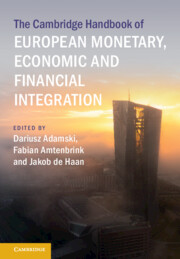Book contents
- The Cambridge Handbook of European Monetary, Economic and Financial Integration
- The Cambridge Handbook of European Monetary, Economic and Financial Integration
- Copyright page
- Contents
- Contributors
- Introduction
- Part I The Economic and Monetary Union
- Part II The Monetary Dimension
- Part III The Economic and Fiscal Dimensions
- Part IV Financial Integration
- 23 Banking Regulation in Europe
- 24 The Politics behind the Creation of the Banking Union
- 25 Failing Banks within the Banking Union at the Crossroads
- 26 The Banking Union
- 27 The Re-emergence of Market-Based Finance?
- 28 The European Strategy on Digital Finance and Its Interplay with Capital Markets Integration in the EU
- 29 Regulating Crypto and Cyberware in the EU
- Index
- References
27 - The Re-emergence of Market-Based Finance?
The Politics of the Capital Markets Union
from Part IV - Financial Integration
Published online by Cambridge University Press: 28 September 2023
- The Cambridge Handbook of European Monetary, Economic and Financial Integration
- The Cambridge Handbook of European Monetary, Economic and Financial Integration
- Copyright page
- Contents
- Contributors
- Introduction
- Part I The Economic and Monetary Union
- Part II The Monetary Dimension
- Part III The Economic and Fiscal Dimensions
- Part IV Financial Integration
- 23 Banking Regulation in Europe
- 24 The Politics behind the Creation of the Banking Union
- 25 Failing Banks within the Banking Union at the Crossroads
- 26 The Banking Union
- 27 The Re-emergence of Market-Based Finance?
- 28 The European Strategy on Digital Finance and Its Interplay with Capital Markets Integration in the EU
- 29 Regulating Crypto and Cyberware in the EU
- Index
- References
Summary
This chapter deals with the Capital Markets Union from a political science perspective. It seeks to explain the initiation and content of the CMU agenda, its fluctuating fortunes, and its prospects. Why did capital markets emerge as a market-based solution in the wake of the European economic crisis, after being seen as part of the problem in the context of the Global Financial Crisis? Moreover, did the CMU represent a historical turn in the EU financial markets integration process? To answer to these questions, the chapter focuses on intergovernmentalist, supranationalist, and transnationalist approaches in international political economy. While intergovernmentalism concerns Member State preferences, electoral incentives, and bargaining power, supranationalism focuses on functional spillovers and the role of supranational actors. Transnationalist frameworks put at the centre the role of cross-border socio-economic interests in shaping dominant discourses and political orientations. The chapter argues that the CMU represented a shift towards market-friendly financial markets regulation in the EU compared to the post-crisis reform wave. Yet, far from being a fully coherent and successful initiative, in its policy outcomes the CMU revealed the fragmentation and multiple conflicts beneath its surface. The CMU remains a relatively narrow and technocratic battlefield among competing coalitions of corporate and policymakers’ interests.
- Type
- Chapter
- Information
- Publisher: Cambridge University PressPrint publication year: 2023

